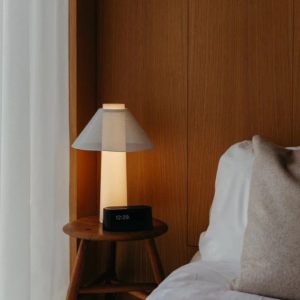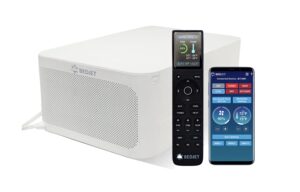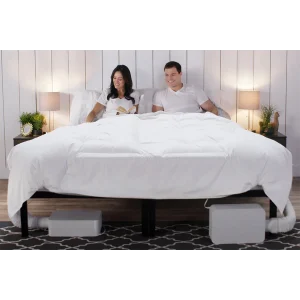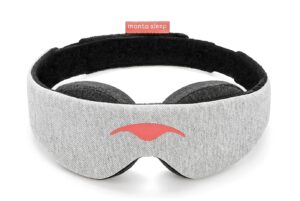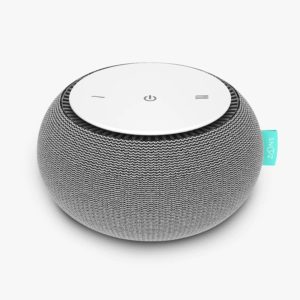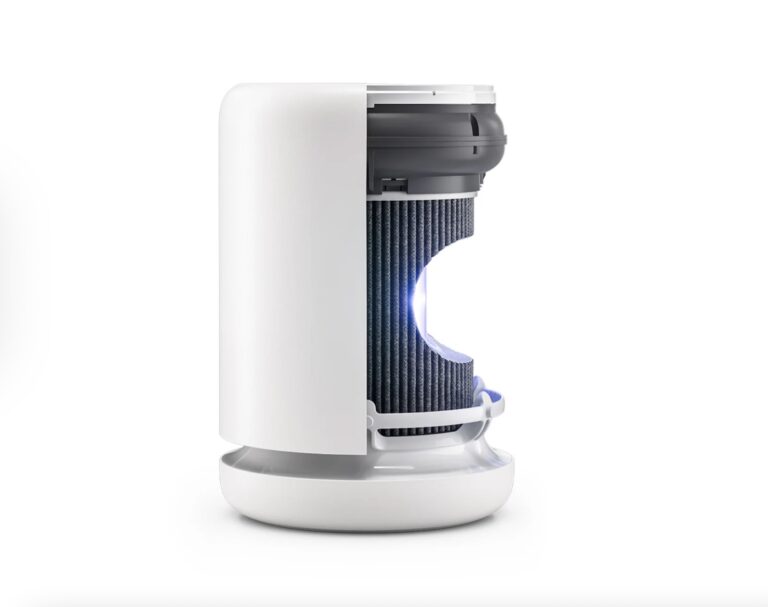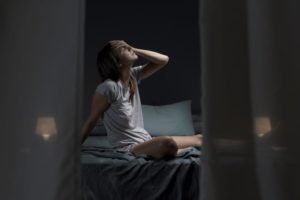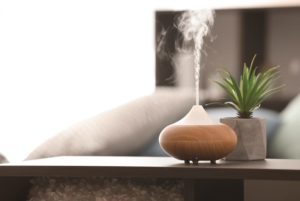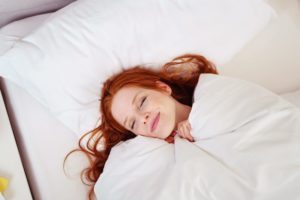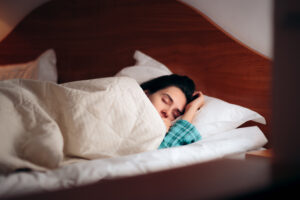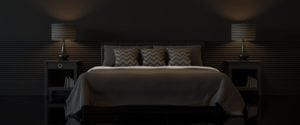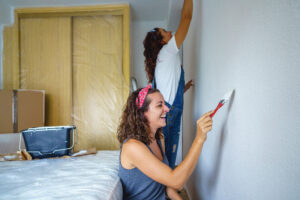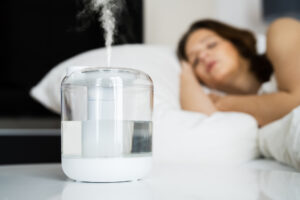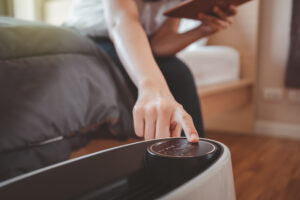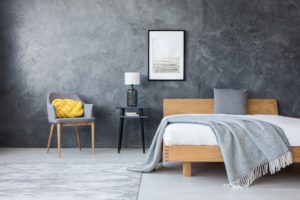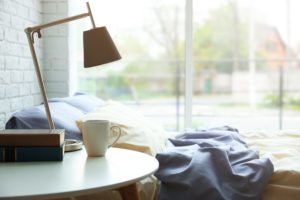When you buy through our links, we may earn a commission. Products or services may be offered by an affiliated entity. Learn more.
How to Design the Ideal Bedroom for Sleep
Your bedroom setting is vital to getting consistent sleep. Creating a bedroom environment that is conducive for falling asleep and staying asleep is a key part of sleep hygiene, which can enable quality rest night after night.
Cultivating a relaxing ambience for sleep involves both visual design and practical setup, including its lighting, sound, and smell. Considering these elements of your sleep setting can help you cultivate your ideal bedroom for optimal sleep.
Visual Design of Your Bedroom
Interior design is a broad concept, but a core component is establishing the look and feel of your home. For your bedroom, you can develop an interior design that not only reflects your personal style but also fosters a sense of calm that promotes sleep.
Warm, Appealing Colors
Your walls, floors, furniture, and bedding all factor into the color scheme of your bedroom. It’s important to emphasize colors that make you feel at ease at bedtime. For most people, these are softer, warmer colors, but you can pick the colors the most appeal to you.
For renters or people on a limited budget, it may not be possible to completely redo the color scheme in your bedroom; however, you can creatively accent certain colors with well-placed bedding, a rug, or wall art.
Usable and Appealing Layout
No matter how much square footage you have to work with, you want to avoid a cramped feeling in your bedroom. Start by choosing a mattress size that fits without being too snug. Utilizing vertical space or underbed storage can make the most of even a small bedroom, freeing up floor space that can be used for handy furniture, like a nightstand, or to give the room an airier feel.
As you design your bedroom, try to make every action you’ll do there frustration-free. For example, organizing your drawers makes it easier to get ready in the morning, and having a clear path from the bed to the bathroom can eliminate tripping hazards if you need to walk to the bathroom in the dark. Designing a stress-free bedroom helps give it an aura of comfort and relaxation.
Reduce Clutter
Visual clutter can generate stress, which is a known barrier to quality sleep. Disorganized items in your bedroom may reinforce the sensation of having too many “loose ends,” generating anxious feelings that may make it harder to relax your mind when you want to fall asleep.
While you don’t necessarily need to go full-on Marie Kondo to get your bedroom organized, it’s worthwhile to review what items you don’t really need and to spend just a few minutes each day picking up clutter so that it doesn’t build up and feel overwhelming to deal with.
A Feeling of Home
Your bedroom should be welcoming, a place where you can unwind and have a sense of being at home. The best way to cultivate this feeling is very personal. Possibilities include displaying pictures of close friends and family, cherished objects that are reminders of favorite memories, or meaningful art or posters on the walls. These personal touches don’t have to be fancy or expensive; instead, they just have to be significant for you.
Practical Design To Promote Sleep
In addition to visual design, the practical setup of your bedroom can directly affect how well you sleep. In general, the goal of these approaches is to make your sleep environment a bastion of physical and mental relaxation that has as few distractions or potential sleep disruptions as possible.
Light
Light is the most powerful cue for your circadian rhythm, part of your biological clock that helps regulate sleep. When it’s time for bed, you want to try to make your bedroom as dark as possible to reinforce a healthy circadian rhythm.
Blackout curtains can help if your room receives lots of exterior light. Lighting, including a bedside lamp if you use one, shouldn’t be too bright. Lighting with a low color temperature and illuminance can make it easier to feel drowsy and doze off.
Another important part of controlling your light exposure is to minimize or eliminate the use of electronic devices, including tablets and cell phones, in your bedroom. Watching TV in the bedroom before going to bed, will negatively impact your sleep quality. Screen time exposes your eyes to blue light that can disrupt your circadian rhythm, and it can also activate your mind, making it harder to wind down for sleep. If you need to keep a device in your bedroom, try to keep it out of arm’s reach and avoid using it for an hour or more before bedtime.
Sound
External noise can cause frequent awakenings , and these disruptions have been tied to reduced levels of both sleep quality and overall health . If outside noise is beyond your control, a white noise machine may help drown the sounds out. You can also set up speakers to play comforting music, which many people use as a way to make their bedroom better suited for falling asleep . Several mobile applications can serve this purpose.
Smell
Having the right scents in your bedroom can be a plus for your sleep. While odors don’t usually cause people to wake up from sleep , they can help cultivate a calming environment for getting quality rest. Studies have found that aromatherapy with essential oils such as lavender can promote relaxation and make it easier to get a good night’s sleep.
Temperature
Your bedroom temperature should be comfortable, usually somewhere between 60 to 71 degrees Fahrenheit (15.6 to 22.0 degrees Celsius). Excess heat can disrupt sleep , so most experts suggest erring on the side of a cooler bedroom.
If you don’t have a thermostat to precisely control the temperature of your bedroom, you can use a fan or, depending on the season, open a window to adjust the temperature.
Air Quality
It might not be the first thing that comes to mind when thinking about setting up your bedroom, but air quality is important for your health. Research has found that ventilation and fresher air is associated with better sleep , and problems like mold buildup have been correlated with insomnia and excessive daytime sleepiness .
Ensuring proper ventilation and avoiding excess humidity can combat mold growth, and regular cleaning can dramatically cut down on dust mites . If you have issues with allergies, you can ask your doctor for recommendations about reducing allergens and/or using hypoallergenic bedding or an air purifier.
Mattress and Bedding
Your bed is, of course, a centerpiece of the bedroom environment. An ideal mattress should be well-built and comfortable, meaning that it meets your personal firmness preference. It should also be supportive and provide appropriate pressure point relief to suit your body weight and sleeping position. A new mattress can be a significant investment, but research has found that it can improve sleep and decrease stress and back pain .
In addition to your mattress, your pillows, sheets, and blankets play an important role in making your bed comfortable and inviting. Pillows can prevent neck pain by keeping your head and spine properly aligned, and your bedding can create a soft and cozy feel while helping to manage your body temperature. Regularly washing your bedding keeps your bed feeling fresh and reduces potential buildup of dust and allergens.

Still have questions? Ask our community!
Join our Sleep Care Community — a trusted hub of sleep health professionals, product specialists, and people just like you. Whether you need expert sleep advice for your insomnia or you’re searching for the perfect mattress, we’ve got you covered. Get personalized guidance from the experts who know sleep best.
References
11 Sources
-
Noguchi, H., & Sakaguchi, T. (1999). Effect of illuminance and color temperature on lowering of physiological activity. Applied human science : journal of physiological anthropology, 18(4), 117–123.
http://www.jstage.jst.go.jp/article/ahs/18/4/18_4_117/_article -
Hume, K. I., Brink, M., & Basner, M. (2012). Effects of environmental noise on sleep. Noise & health, 14(61), 297–302.
http://www.noiseandhealth.org/text.asp?2012/14/61/297/104897 -
Halperin D. (2014). Environmental noise and sleep disturbances: A threat to health?. Sleep science (Sao Paulo, Brazil), 7(4), 209–212.
https://pubmed.ncbi.nlm.nih.gov/26483931/ -
Trahan, T., Durrant, S. J., Müllensiefen, D., & Williamson, V. J. (2018). The music that helps people sleep and the reasons they believe it works: A mixed methods analysis of online survey reports. PloS one, 13(11), e0206531.
https://pubmed.ncbi.nlm.nih.gov/30427881/ -
Carskadon, M. A., & Herz, R. S. (2004). Minimal olfactory perception during sleep: why odor alarms will not work for humans. Sleep, 27(3), 402–405.
https://pubmed.ncbi.nlm.nih.gov/15164891/ -
Lillehei, A. S., & Halcon, L. L. (2014). A systematic review of the effect of inhaled essential oils on sleep. Journal of alternative and complementary medicine (New York, N.Y.), 20(6), 441–451.
https://pubmed.ncbi.nlm.nih.gov/24720812/ -
Okamoto-Mizuno, K., & Mizuno, K. (2012). Effects of thermal environment on sleep and circadian rhythm. Journal of Physiological Anthropology, 31(1), 14.
https://pubmed.ncbi.nlm.nih.gov/22738673/ -
Vojta, P. J., Randels, S. P., Stout, J., Muilenberg, M., Burge, H. A., Lynn, H., Mitchell, H., O’Connor, G. T., & Zeldin, D. C. (2001). Effects of physical interventions on house dust mite allergen levels in carpet, bed, and upholstery dust in low-income, urban homes. Environmental health perspectives, 109(8), 815–819.
https://pubmed.ncbi.nlm.nih.gov/11564617/ -
Wang, J., Janson, C., Lindberg, E., Holm, M., Gislason, T., Benediktsdóttir, B., Johannessen, A., Schlünssen, V., Jogi, R., Franklin, K. A., & Norbäck, D. (2020). Dampness and mold at home and at work and onset of insomnia symptoms, snoring and excessive daytime sleepiness. Environment international, 139, 105691.
https://linkinghub.elsevier.com/retrieve/pii/S0160412020301008 -
Strøm-Tejsen, P., Zukowska, D., Wargocki, P., & Wyon, D. P. (2016). The effects of bedroom air quality on sleep and next-day performance. Indoor air, 26(5), 679–686.
https://onlinelibrary.wiley.com/doi/10.1111/ina.12254 -
Jacobson, B. H., Boolani, A., & Smith, D. B. (2009). Changes in back pain, sleep quality, and perceived stress after introduction of new bedding systems. Journal of Chiropractic Medicine, 8(1), 1–8.
https://pubmed.ncbi.nlm.nih.gov/19646380/


